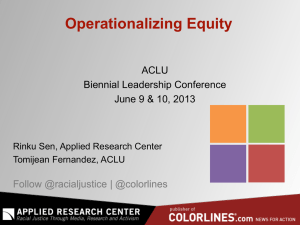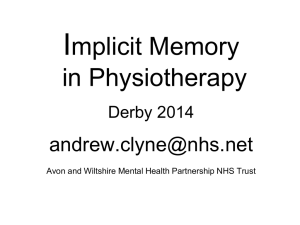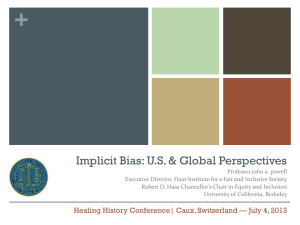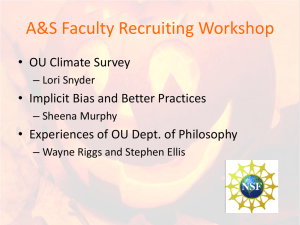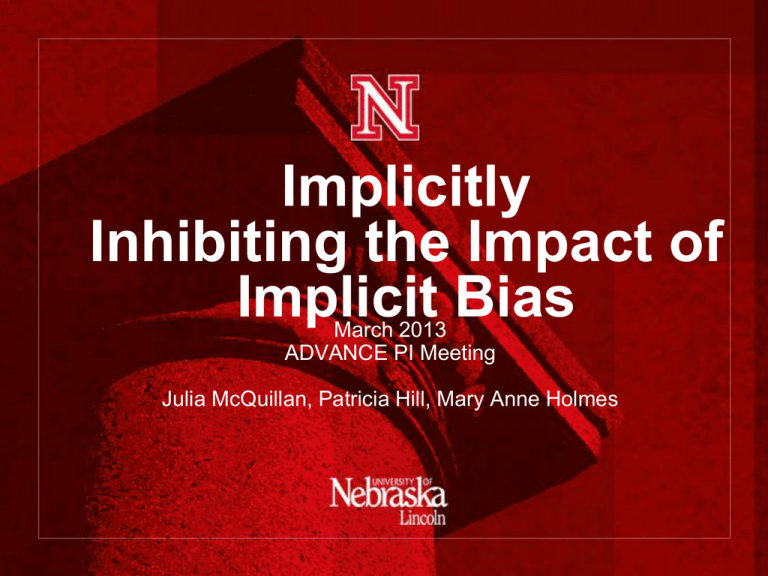
Implicitly
Inhibiting the Impact of
Implicit Bias
March 2013
ADVANCE PI Meeting
Julia McQuillan, Patricia Hill, Mary Anne Holmes
What is implicit bias?
Automatic Associations (Scientist = Male)
Who has implicit biases?
Even the most wellintentioned person
unwillingly allows
unconscious thoughts &
feelings to influence
apparently objective
decisions.
~ M. Banaji
4
Benefits: Diversity creates more
innovation (Scott Page 2007)
Challenge: automatic ingroup preferences, more
work to communicate,
tokenism if < 30%, need a
common goal
Gender Inequality Persists because of
cognitive gender “Frames”
How can I learn more – in an
enjoyable way?
https://implicit.harvard.edu/implicit/
Can’t professors judge ‘excellence’
without gender frames interfering?
Lamont observed
academic review panels
- Quality is the goal
- Many biases (e.g.
disciplines, institutional
prestige)
How can we limit the impact of
Implicit Bias?
• Accountability
• Formal Systems –
details
• Heterogeneous
Groups
• Inter-Group
Contact
• Create new
associations
What is the ADVANCE-Nebraska
team doing about Implicit Attitudes?
• Faculty Committee
• – raise awareness
– Best practices
– Presentations
• New Images/Associations
– Speakers
– Paths to Success
– Showcase visits
– Conversations
• Data – available/here
• Rubrics
Is awareness necessary?
Potential Benefits:
•
•
•
•
Action to limit damage
Creativity in limiting impact
Openness to data
Realization that everyone
needs help minimizing the
impact of implicit bias
• Willingness to slow down
• Acceptance of rubrics
Is awareness Unnecessary?
Can we implicitly inhibit implicit bias?
* Enhance clarity/reduce ambiguity
– Create Rubrics for hiring, T&P, evaluation
– Data for review organized for comparison
*Accountability
– Data patterns – relative to pools – consequences of
underrepresentation
– Ask for accounts of decisions
*Adequate time for careful review
– Reward review work/provide time
– Equity advocates/procedure focus
*Create new implicit Associations
– Images that disrupt implicit associations (e.g. more images
of women in STEM)
– Extra efforts/constantly searching
– Showcase visits (new association
Thank you!
jmcquillan2@unl.edu
©2007 The Board of Regents of the University of Nebraska
Implicit Bias References
www.implicit .harvard .edu, http://wiseli.engr.wisc.edu/
Aberson, C.L., & S. C. Haag, 2007. Contact, perspective taking, and anxiety as predictors of stereotype
endorsement, explicit attitudes, and implicit attitudes. Group Processes & Intergroup Relations 10(2), 179-201.
Armor, D. A. (999). The illusion of objectivity: A bias in the perception of freedom from bias (Doctoral
dissertation, ProQuest Information & Learning).
Banaji, M. R., Bazerman, M. H., & Chugh, D. (2003). How (un) ethical are you?. Harvard Business Review,
81(12), 56-65.
Barres, B. A. (2006). Does gender matter?. Nature, 442(7099), 133-136.
Beardslee, D.C.; D.D O'Dowd (1961). "The College-student Image of the Scientist". Science 133 (3457): 997–
1001. doi:10.1126/science.133.3457.997. PMID 17743790.
Bertrand, M.& Mullainathan, S. 2005. Implicit discrimination.The American Economic Review,95(2),94-98.
Bertrand, M., & Mullainathan, S. (2003). Are Emily and Greg more employable than Lakisha and Jamal? A field
experiment on labor market discrimination (No. w9873). National Bureau of Economic Research.
Bielby, W. T. (2000). Minimizing workplace gender and racial bias. Contemporary Sociology, 120-129.
Blair, I. V. (2002). The malleability of automatic stereotypes and prejudice. Personality and Social Psychology
Review, 6(3), 242-261.
Carnes, M., P. G. Devine, C. Isaac, L. B. Manwell, C. E. Ford, Angela Byars-Winston, Eve Fine, and Jennifer
Sheridan. 2012. Promoting Institutional Change Through Bias Literacy. Journal of Diversity in Higher Education.
5:2:63-77.
Chambers, D. W.(1983). Stereotype images of the scientist, the draw-a-scientist test. Science.Chambers, D.W.
(1983). "Stereotypic Images of the Scientist: The Draw a Scientist Test".Science Education 67 (2): 255–
265. doi:10.1002/sce.3730670213.
Chen, Ya-Ru, Randall Peterson, Damon Phillips, and Cecilia Ridgeway. “Bringing Status Back to the Table:
Attaining, Maintaining, and Experiencing Status in Organizations and Markets.” Organizational Science, 2012,
23 (2-Apr):299-307.
Dovidio, J. F., Kawakami, K., & Gaertner, S. L. (2000). Reducing contemporary prejudice: Combating explicit
and implicit bias at the individual and intergroup level.
Finson, K. D., 2010. Drawing a scientist: What we do and do not know after fifty years of drawings. School
Science and Mathematics, 102(7), 335-345.
Finson, K. D., Beaver, J. B., & Cramond, B. L., 2010. Development and field test of a checklist for the
Draw‐A‐Scientist Test. School Science and Mathematics, 95(4), 195-205.
Flick, L., 1990. Scientist in Residence Program Improving Children's Image of Science and Scientists. School
Science and Mathematics, 90: 204–214. doi: 10.1111/j.1949-8594.1990.tb15536.x
Gladwell, Malcolm. 2005. Blink: The Power of Thinking Without Thinking. Backbay Books. New York.
Grande, D.; Frosch, D. L.; Perkins, A. W.; et al. 2009. Effect of Exposure to Small Pharmaceutical Promotional
Items on Treatment Preferences. ARCHIVES OF INTERNAL MEDICINE. 169: 9: 887-893.
Green, T., & Kalev, A. (2008). Discrimination-Reducing Measures at the Relational Level. Hastings Law Journal,
59, 1435.
Greenwald, Anthony, Debbie McGhee, and Jordan Schwartz. 1998. “A person's automatic association between
mental representations of objects”.
Greenwald, A. G., McGhee, D. E., & Schwartz, J. K. L. (1998). Measuring individual differences in implicit
cognition: The Implicit Association Test. Journal of Personality and Social Psychology, 74, 1464-1480.
Greenwald, A. G., McGhee, D. E., & Schwartz, J. K. L. (1998). Measuring individual differences in implicit
cognition: The Implicit Association Test. Journal of Personality and Social Psychology, 74, 1464-1480.
Greenwald, A. G., & Banaji, M. R. (1995). Implicit social cognition: attitudes, self-esteem, and stereotypes.
Psychological review, 102(1), 4.
Greenwald, A. G., & Krieger, L. H. (2006). Implicit bias: Scientific foundations. California Law Review, 94(4),
945-967.
Hodges, M. J., & Budig, M. J. (2010). Who gets the daddy bonus? Organizational hegemonic masculinity and
the impact of fatherhood on earnings. Gender & Society, 24(6), 717-745.
Holladay, C. L., & Quinones, M. A. (2005). Reactions to diversity training: An international comparison. Human
Resource Development Quarterly, 16(4), 529-545.
Holmes, M. A., Asher, P., Farrington, J., Fine, R., Leinen, M. S., & LeBoy, P. (2011). Does gender bias influence
awards given by societies?. Eos, Transactions American Geophysical Union, 92(47), 421.
Johnson, J.., S. Rush, J. Feagin. 1995. “Reducing Inequalities: Doing Anti-Racism.” Symposium
Jordan, A. H., & Zitek, E. M. (2012). Marital Status Bias in Perceptions of Employees. Basic and Applied Social
Psychology, 34(5), 474-481.
Jost, J.T., L. A. Rudman, I. V. Blair, D. R. Carney, N. Dasgupta, J. Glaswer, C. D. Hardin, “The Existence of Implicit Bias
is Beyond reasonable doubt: A Refutation of Ideological and Methodological Objections and Executive Summary of Ten
Studies that No Manager Should Ignore.” Research in Organizational Behavior. 29. (2009) 39-69.
Kanter, Rosabeth Moss; Stein, Barry A. (June 1986). A tale of "O": on being different in an organization. Harper &
Row.ISBN 978-0-06-132064-4.
Lamont, Michèle . How Professors Think: Inside the Curious World of Academic Judgement. Harvard University Press.
Boston: MA.
Lebrecht, Sophie, Lara J. Pience, Michael J. Tarr, James W. Tanaka. 2009. Perceptual Other-Race Training Reduces
Implicit Racial Bias. PLos ONE. 4:1:e4215.
Lowery, B. S., Hardin, C. D., & Sinclair, S. (2001). Social influence effects on automatic racial prejudice. Journal of
personality and social psychology, 81(5), 842.
Madera, J. M., Hebl, M. R., & Martin, R. C. (2009). Gender and letters of recommendation for academia: Agentic and
communal differences. Journal of Applied Psychology, 94(6), 1591.
Mark, Noah, Lynn Smith-Lovin, and Cecilia L. Ridgeway. “Why Do Nominal Characteristics Acquire Status Value? A
Minimal Explanation for Status Construction.” American Journal of Sociology, 2009, 115 (3-Nov):832-862.
Martell, R. F., Lane, D. M., & Emrich, C. (1996). Male-female differences: A computer simulation.
Moss-Racusin, C. A., J.F. Dovidio, V. L. Brescoll, M.J. Graham, and J. Handelsman, 2012. Science faculty’s subtle
gender biases favor male students. Proc. Natl Acad Sciences, DOI 10.1073/pnas.1211286109
Page, S. E. (2007). The Difference: How the Power of Diversity Creates Better Groups, Firms, Schools, and Societies.
Princeton: Princeton University Press.
Phelan, J. E., Moss‐Racusin, C. A., & Rudman, L. A. 2008. Competent yet out in the cold: Shifting criteria for hiring
reflect backlash toward agentic women. Psychology of Women Quarterly, 32(4), 406-413.
Reskin, B. (2005). Including mechanisms in our models of ascriptive inequality. Handbook of Employment Discrimination
Research, 75-97.
Reskin, B. F., & McBrier, D. B. (2000). Why not ascription? Organizations' employment of male and female managers.
American sociological review, 210-233.
Ridgeway, C. L. 2009. “Framed Before We Know It: How Gender Shapes Social Relations.” Gender & Society.
23(2-Apr):145-160.
Ridgeway, C. L. 2011. Framed by Gender: How Gender Inequality Persists in the Modern World. New York:
Oxford University Press.
Ridgeway, C. L. (2006). Linking social structure and interpersonal behavior: A theoretical perspective on cultural
schemas and social relations. Social Psychology Quarterly, 69(1), 5-16.
Rudman, L. A., Ashmore, R. D., & Gary, M. L. (2001). " Unlearning" automatic biases: the malleability of implicit
prejudice and stereotypes. Journal of Personality and Social Psychology; Journal of Personality and Social
Psychology, 81(5), 856.
Schibeci, R. A. Sorensen. I.(1983). Elementary school children’s perceptions of scientists. School Science and
Mathematics, 83(1), 14-20.
Schmader, T., Whitehead, J., & Wysocki, V. H. (2007). A linguistic comparison of letters of recommedation for
male and female chemistry and biochemistry job applicants. Sex roles, 57(7), 509-514.
Simpson, Brent, Robb Willer, and Cecilia L. Ridgeway. “Status Hierarchies and the Organization of Collective
Action.” Sociological Theory, 2012, 30(3-Sept): 149-166.
Smith-Doerr, L. (2004). Women's Work: Gender Equality vs. Hierarchy in the Life Sciences. Lynne Rienner Pub.
Sommers, S. R. 2006. On racial diversity and group decision making: Identifying multiple effects of racial
composition on jury deliberations. Journal of Personality and Social Psychology, Vol 90(4), Apr, 2006. pp. 597612.
Steinpreis, R. E., Anders, K. A., & Ritzke, D. (1999). The impact of gender on the review of the curricula vitae of
job applicants and tenure candidates: A national empirical study. Sex roles, 41(7), 509-528.
Sturm, S. (2006). Architecture of Inclusion: Advancing Workplace Equity in Higher Education, The. Harv. JL &
Gender, 29, 247.
Trix, F., & Psenka, C. (2003). Exploring the color of glass: Letters of recommendation for female and male
medical faculty. Discourse & Society, 14(2), 191-220.
Valian, V. (2005). Beyond gender schemas: Improving the advancement of women in academia. Hypatia, 20(3),
198-213.
Wood, W. and C. L. Ridgeway. “Gender: An Interdisciplinary Perspective.” Social Psychology Quarterly, 2010,
73 (4-Dec): 334-339.

